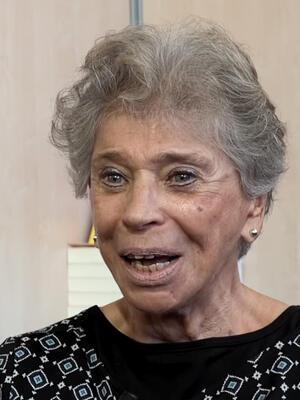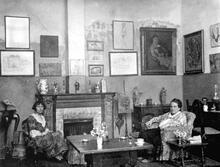Vivian Gornick
For Vivian Gornick, self-narrative is a form of cultural criticism: The personal is decidedly political. Born in the Bronx, she grew up in a family of working-class immigrants with parents who were committed Communists. Since the 1960s, she has been a writer of journalism, essays, and memoirs. Much of her writing explores the actual and metaphoric significance of being an outsider—perpetually “half in, half out.” Despite her claim that feminism ended her attachment to Judaism, the experience of being “twice an outsider” (Jewish and female) serves for her as a powerful lesson in marginality. In works on feminist radicals Elizabeth Cady Stanton and Emma Goldman, she has expanded the autobiographical form to include the biographical, offering an ideological and genealogical starting point for Gornick’s own involvement in second wave feminism.
For Vivian Gornick, self-narrative is a form of cultural criticism: The personal is decidedly political. As a staff writer for the Village Voice during the early 1970s, Gornick reported on the explosion of American feminist consciousness through the prism of her own experience, and that willingness to use her own life experiences to tell a larger social story has become the hallmark of her writing. While she acknowledges her Jewish background in much of her work, Gornick marks the urgency of her feminist struggle for “possession of the self” as the force that drives her creative endeavors (Essays 169). “It is here, on the issue of being a woman, not a Jew, that I must make my stand and hold my ground,” she explained in Tikkun (1989).
Early Life and Career
Vivian Gornick was born on June 14, 1935, in the Bronx, the youngest of Louis and Bess Gornick’s two children. Her Ukrainian-born parents, whom Gornick describes as “harried, working-class immigrants,” were committed Communists who met and married in New York. Her father worked as a presser in a dress factory for thirty years, and her mother was a bookkeeper and office clerk. When Gornick was thirteen years old, her father died suddenly of a heart attack. Her memoir, Fierce Attachments (1987), paints a vivid picture of growing up in “a building full of women” with a mother immersed in her own mourning.
Gornick received her BA from City College of New York in 1957 and completed her MA in Literature at New York University in 1960. Next, Gornick moved to California to pursue a PhD at Berkeley. There, she was briefly married to a painter with whom she shared a bohemian apartment. Following their divorce, Gornick left Berkeley and returned to the East Coast. After teaching English at the State University of New York at Stony Brook in 1966–1967 and at Hunter College in 1967–1968, she worked as a reporter for the Village Voice from 1969 to 1977, while also writing for publications such as The Nation, the New York Times, and the Atlantic. Gornick was briefly married and divorced a second time in the late 1960s. Many of Gornick’s articles from this period are collected in Essays in Feminism (1978) and reflect the revolutionary excitement of the growing women’s movement. Since leaving the Village Voice, she has divided her time between free-lance writing and teaching in creative writing programs. She is based in New York City.
Early Journalistic and Literary Works
Whether she is writing impressionistic journalism or memoir, Vivian Gornick explores the actual and metaphoric significance of being an outsider—perpetually “half in, half out.” Her groundbreaking anthology, Woman in Sexist Society: Studies in Power and Powerlessness, coedited in 1971 with Barbara K. Moran, places women alongside the prototypical Wandering Jew and Noble Savage, symbolically “beyond the pale of ordinary human existence” (71). Such a vantage point not only provides valuable perspective for critiquing society, it also encourages “the camaraderie of the outsider” that allows her to write sympathetically about all marginalized groups (In Search of Ali Mahmoud 7). For In Search of Ali Mahmoud: An American Woman in Egypt (1973), Gornick traveled to Egypt to explore the culture of a former lover, which she depicts as simultaneously exotic and familiar. Her impression that American women and Egyptian men experience similar kinds of powerlessness is heightened by her perception of herself as “the original stranger” (94)—a Jew in an Arab land.
Interviewing one hundred former communists for The Romance of American Communism (1977), Gornick examined how their politics enabled them to live “at a level of intense expressiveness” (Perry 118). This passion for understanding what allows the outsider to become an “experiencing self” is echoed in Women in Science: Portraits from a World in Transition (1983), where science—like feminism—becomes a means of “demystifying the self and the environment” (162). Fierce Attachments: A Memoir (1987) portrays Gornick’s own determination to lead a life of the mind and to transcend “the daily infliction of social invisibility” that women experience as outsiders (“Twice an Outsider” 123). Weaving together past and present through a series of conversations and encounters with her mother, Gornick uses their complex relationship as the frame for her exploration of the meaning of success, freedom, and love. Her collection of essays, Approaching Eye Level (1996), depicts Gornick’s ongoing effort to attain “the dense and original quality of life on the margin” by experiencing the action and rhythm of the streets of New York.
Gornick’s work powerfully evokes the urban Jewish American milieu of her childhood and reflects unflinchingly on the parallel humiliations of antisemitism and sexism. Despite her claim that “feminism absolutely ended” her emotional attachment to Judaism (Swenson, 16), the experience of being “twice an outsider”—both Jewish and a woman—serves for Gornick as a powerful lesson in marginality. “Being Jewish ... lives in me as a vital subculture,” she explains, “enriching my life as a writer, as an American, and certainly as a woman” (“Twice an Outsider” 125).
Later Works
American writer Vivian Gornick on writers and New York, feminism, and the importance of books.
Gornick’s career as a writer and essayist continues to flourish in the twenty-first century. Republication of some of her earlier works, such as Women in Science (with new additions), Taking a Long Look (2021; an anthology of previously published essays), and The Romance of American Communism (1977/2020), has enabled her to reach a new and younger audience. The themes of feminism, Jewishness, and questions of writing the self continue to dominate Gornick’s work, complemented by a more recent focus on how encounters with literature shape the self. In the tongue-in-cheek-titled collection The Men In My Life (2008), Gornick turns to canonical male writers such as Saul Bellow, Philip Roth, Allen Ginsberg, and James Baldwin, among others. She unpacks how the self-loathing and lonely masculinity that saturates their works shapes the nature of female characters on the margins and analyzes how misogyny renders these characters as mere foils for male fantasy and resentment.
In Unfinished Business: Notes of a Chronic Re-Reader (2020), Gornick revisits works by writers such as Colette, Marguerite Duras, and A. B. Yehoshua, which had been formative reading experiences for her. In her re-readings, Gornick adds a memoiristic layer to her essays. She recalls her young adulthood and time at The Village Voice, during which she first encountered these writers and thus forges a hybrid genre of so-called “personal criticism.”
This personal and memoiristic element in Gornick’s criticism takes on a more full-fledged role in her (auto)biographical works that center women’s lives. The memoir The Odd Woman and the City (2015) continues themes and forms from Gornick’s renowned memoir about her relationship with her mother Fierce Attachments; it, too, is structured around a close interpersonal relationship (in this case, with a gay man named Leonard) that plays out in short vignettes set in New York City. In addition to discussing literature and film and revisiting the mother motif, The Odd Woman and the City also includes short biographies of lesser-known women writers, such as Evelyn Scott and Mary Britton Miller. This expansion of the autobiographical form to include the biographical is an extension of Gornick’s work on feminist radicals Elizabeth Cady Stanton and Emma Goldman in The Solitude of Self: Thinking about Elizabeth Cady Stanton (2005) and Emma Goldman: Revolution as a Way of Life (2011). This suffragist and anarchist, respectively, offer an ideological and genealogical starting point for Gornick’s own involvement in the second wave feminist movement and serve as a foil against which she constructs a contemporary feminist identity.
Selected Works by Vivian Gornick
Taking A Long Look: Essays on Culture, Literature and Feminism in Our Time. New York: Verso, 2021.
Unfinished Business: Notes of a Chronic Re-Reader. New York: Farrar, Straus, and Giroux, 2020.
The Odd Woman and the City: A Memoir. New York: Farrar, Straus, and Giroux, 2015.
Emma Goldman: Revolution as a Way of Life. New Haven, CT: Yale University Press, 2011.
Women in Science: Then and Now. New York: Feminist Press, 2009.
The Men In My Life. Cambridge,MA: MIT Press, 2008.
The Solitude of Self: Thinking about Elizabeth Cady Stanton. New York: Farrar, Straus, and Giroux, 2005.
The Situation and the Story: The Art of Personal Narrative. New York: Farrar, Straus, and Giroux, 2001.
The End of the Novel of Love. Boston: Beacon Press, 1997.
Approaching Eye Level. Boston: Beacon Press, 1996.
“The Reliable Reporter and the Untrustworthy Narrator.” Soundings: An Interdisciplinary Journal 76, no. 2–3 (Summer/Fall 1993): 267–280.
Introduction to How I Found America: Collected Stories of Anzia Yezierska. New York: Persea Books, 1991.
“Twice an Outsider: On Being Jewish and a Woman.” Tikkun: A Bimonthly Jewish Critique of Politics, Culture & Society 4, no. 2 (March/April 1989): 29+.
Introduction to Wasteland, by Jo Sinclair. Philadelphia: Jewish Publication Society, 1987.
Fierce Attachments: A Memoir. New York: Farrar, Straus, and Giroux, 1987.
Women in Science: Portraits from a World in Transition. New York: Simon and Schuster, 1983.
Essays in Feminism. New York: Harper & Row, 1978.
The Romance of American Communism. New York: Basic Books, 1977.
In Search of Ali Mahmoud: An American Woman in Egypt. New York: EP Dutton, 1973.
Woman in Sexist Society: Studies in Power and Powerlessness, coedited with Barbara K. Moran. New York: New American Library, 1971.
The Situation and the Story: The Art of Personal Narrative. New York: Farrar, Straus, and Girous, 2001.
Burstein, Janet H. “A Response to Vivian Gornick.” Soundings: An Interdisciplinary Journal 76, no. 2–3 (Summer/Fall 1993): 285–288.
Cousineau, Diane. “Women and Autobiography: Is There Life Beyond the Looking Glass?” Caliban 31 (1994): 97–105.
Laufer, Pearl David. “Powerful and Powerless: Paradox in Vivian Gornick’s Fierce Attachments.” In Mother Puzzles: Daughters and Mothers in Contemporary American Literature, edited by Mickey Pearlman. New York: Greenwood Press, 1989.
Perry, Donna Marie. “Interview with Vivian Gornick.” Backtalk: Women Writers Speak Out. New Brunswick, NJ: Rutgers University Press, 1993.
Porter, Dale H. “A Response to Gornick.” Soundings: An Interdisciplinary Journal 76, no. 2–3 (Summer/Fall 1993): 281–284.
Swenson, Linda Fader. “Facing Down Secret Fears and Unbearable Wisdoms: An Interview with Vivian Gornick.” Hayden’s Ferry Review 12 (Spring/Summer 1993): 7–19.
“Vivian Gornick.” Contemporary Authors: A Bio-Bibliographical Guide to Current Writers in Fiction, General Nonfiction, Poetry, Journalism, Drama, Motion Pictures, Television, and Other Fields, edited by Frances C. Locher. Vol. 101. Detroit, MI: Gale Group, 1981).
Farber, Stephanie S., and Vivian Gornick. "Interview with Vivian Gornick." Fourth Genre: Explorations in Nonfiction 8, no. 2 (2006): 133-49
Kahane, Claire. “The Smile of the Cheshire Cat: Uncovering the Author in the Text.” Women's Studies, 39:2 (2019): 119-135.
Prior, K.S. “Vivian Gornick’s Elegy for the Novel?”.Acad. Quest. 33 (2020): 635–639.





